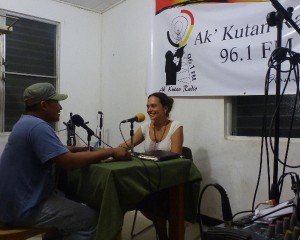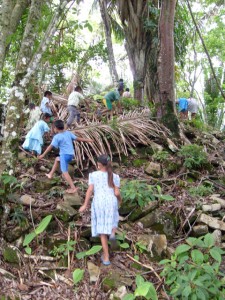Monday, May 7th, 2012...12:10 pm
A Path Linking Past and Present: Ethnobotanical Trail Highlights Maya Environmental and Cultural Heritage in Southern Belize
I have been working with a dynamic group of anthropologists, educators, non-government organizations, parents and children in Belize to develop a curricula to support and sustain environmental and cultural heritage in Mopan and Q’eqchi’ Maya communities of southern Belize.
USF doctoral candidate Kristina Baines and I worked with a community association, Uchb’enka K’in Ahaw Association (UKAA), and the University of South Florida Botanical Garden to create signage for 40 culturally significant plants with their local names and uses on an interpretive trail at an ancient Maya site in their community.
Student workbooks and teachers guides focused on environmental and cultural heritage will be distributed to primary and secondary teachers throughout the Toledo district, Belize. The curriculum is the result of three years of pilot testing, teacher feedback, and collaboration with Maya leaders, NGOs, and educators, representing the efforts of the Toledo Environmental and Cultural Heritage Alliance (TEACHA). Much of the information in the workbooks was collected as part of my dissertation research in Toledo and over the last decade, so it is exciting to see how the project has developed over the years.
The student and teacher workbooks incorporate a series of experiential lessons related to topics and themes prioritized by Maya educators and activists. Radio broadcasts on a local radio station, Ak’ Kutan Radio at the Tumul K’in Center of Learning, feature a call-in show for discussion about the cultural importance of local plants. Materials for a guided tour of the community plant trail at the Uxb’enka archaeological site in Santa Cruz, Toledo will be available for students, radio listeners, and other visitors. Maya children and youth who have participated in the project thus far enjoy seeing, hearing, and learning in a different context as they also encounter new knowledge. This project supports the dynamic nature of cultural and environmental heritage by promoting sharing, discussion, collaboration, and experiential learning.
This project is funded by the National Science Foundation, Human Social Dynamics program and the Anthropology and Environment Section of the American Anthropological Association Small Grants for Collaborative Problem Solving. Toledo Environmental and Cultural Heritage Alliance (TEACHA) was initiated as part of the education plan of a collaborative research grant, “Development and resilience of complex socioeconomic systems: A theoretical model and case study from the Maya Lowlands,” supported by the U. S. National Science Foundation, Human Social Dynamics program, Award number 0827277.
In collaboration with
Uchb’enka K’in Ahaw Association (UKAA), Santa Cruz, Toledo District, Belize
University of South Florida Botanical Gardens, Tampa, Florida, USA
Tumul K’in Center of Learning, Blue Creek, Toledo District, Belize
For more detailed information on this project contact:
Dr. Rebecca Zarger, Dept. of Anthropology, University of South Florida
Email: rzarger_at_usf.edu
http://anthropology.usf.edu/faculty/zarger/
http://anthropology.usf.edu/news/research/
National Science Foundation Human Social Dynamics project site (Douglas Kennett, PI): http://mayasim.uoregon.edu/
Toledo Environmental and Cultural Heritage Alliance: www.teacha.org


Comments are closed.